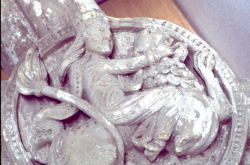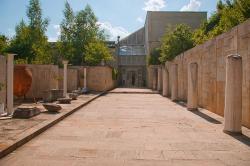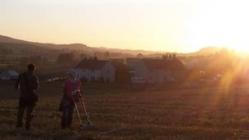INSTITUT SUPERIEUR D'ANTHROPOLOGIE
INSTITUTE OF ANTHROPOLOGY
ONLINE COURSES / COURS A DISTANCE
INSCRIPTION : Année Universitaire 2012/2013
REGISTRATION : Academic Year 2012 / 2013
ROYAUME UNI –  Bath - A fascinating event staged by Bath & North East Somerset Council is offering people the chance to see unusual archaeological finds from Combe Down Stone Mines and Keynsham. The collection includes Roman mosaics which have not been on public display for over a decade and intricate stonework from Keynsham Abbey. The "What's in Store?" event takes place at the Pixash Lane Store, next to Pixash Lane Recycling Centre, between Saltford and Keynsham on Saturday 3 November, from 11am to 3pm. The collection of archaeological artefacts on display includes Medieval items found in the 1961 excavation of Keynsham Abbey. There are fascinating pieces of medieval stone work including three bosses, believed to be from the Chapter House, the best of which depicts Samson and the lion. There are also a great number of glazed floor tiles including some with griffins, birds and complex intertwining patterns. Mosaic panels discovered when the Roman Villa was excavated in the 1920s; including a near complete panel depicting the Roman tale of Europa and the Bull. Finds excavated from the stone mines under Combe Down; including pieces of worked stone; some huge blocks, others small apprentice pieces; but also many iron tools and beer bottles and clay pipes used by the miners.
Bath - A fascinating event staged by Bath & North East Somerset Council is offering people the chance to see unusual archaeological finds from Combe Down Stone Mines and Keynsham. The collection includes Roman mosaics which have not been on public display for over a decade and intricate stonework from Keynsham Abbey. The "What's in Store?" event takes place at the Pixash Lane Store, next to Pixash Lane Recycling Centre, between Saltford and Keynsham on Saturday 3 November, from 11am to 3pm. The collection of archaeological artefacts on display includes Medieval items found in the 1961 excavation of Keynsham Abbey. There are fascinating pieces of medieval stone work including three bosses, believed to be from the Chapter House, the best of which depicts Samson and the lion. There are also a great number of glazed floor tiles including some with griffins, birds and complex intertwining patterns. Mosaic panels discovered when the Roman Villa was excavated in the 1920s; including a near complete panel depicting the Roman tale of Europa and the Bull. Finds excavated from the stone mines under Combe Down; including pieces of worked stone; some huge blocks, others small apprentice pieces; but also many iron tools and beer bottles and clay pipes used by the miners.
http://www.thisisbath.co.uk/Keynsham-event-uncovers-archaeological-finds/story-17015372-detail/story.html
BULGARIE –  Veliki Preslav - “We found an incredibly interesting and one of its kind set of 11 bronze pen nibs, which used to be put on the pens during the Golden Age of Simeon I of Bulgaria,” archaeologist Professor Nikolay Ovcharov announced for FOCUS News Agency, commenting on the findings at the Patriarch Basilica at the palace complex of the Veliko Preslav historical and archaeological reserve. “The pen nibs were used during the time of the literary school of the First Bulgarian Kingdom of Simeon I of Bulgaria. They were in a separate bag and were used for the processing and making of books – not only for writing but also for miniatures – for the best we know that has been happening during the Golden Age of Simeon I of Bulgaria,” Ovcharov remarked. “Each of these pen nibs, which are cone-shaped, has different diameter, which means that they were supposed to make different lines of ink – wider, smaller and so on,” Professor Ovacharov commented further. “It is something similar to the great novel The Name of the Rose by Italian author Umberto Eco and monk Adelmo, who in the XII-XIII century writes books and illustrates them with wonderful miniatures. Something similar we see illustrated during the Golden Age of Simeon I of Bulgaria,” Ovacharov explained.
Veliki Preslav - “We found an incredibly interesting and one of its kind set of 11 bronze pen nibs, which used to be put on the pens during the Golden Age of Simeon I of Bulgaria,” archaeologist Professor Nikolay Ovcharov announced for FOCUS News Agency, commenting on the findings at the Patriarch Basilica at the palace complex of the Veliko Preslav historical and archaeological reserve. “The pen nibs were used during the time of the literary school of the First Bulgarian Kingdom of Simeon I of Bulgaria. They were in a separate bag and were used for the processing and making of books – not only for writing but also for miniatures – for the best we know that has been happening during the Golden Age of Simeon I of Bulgaria,” Ovcharov remarked. “Each of these pen nibs, which are cone-shaped, has different diameter, which means that they were supposed to make different lines of ink – wider, smaller and so on,” Professor Ovacharov commented further. “It is something similar to the great novel The Name of the Rose by Italian author Umberto Eco and monk Adelmo, who in the XII-XIII century writes books and illustrates them with wonderful miniatures. Something similar we see illustrated during the Golden Age of Simeon I of Bulgaria,” Ovacharov explained.
http://www.focus-fen.net/index.php?id=n288661
ROYAUME UNI – Tullos Hill - A programme of archaeological work carried out on Aberdeen's Tullos Hill will be the focus of a talk at Aberdeen Maritime Museum on Wednesday, 10 October. Ian Suddaby, an archaeologist with Edinburgh-based CFA Archaeology, will speak about the recent community dig on the hill this summer as well the discoveries made during surveys in 2004 and 2012 and previous excavations in 2010. Tullos Hill has long been known as an important archaeological landscape because of the four Bronze Age burial cairns there: Cat Cairn; Baron's Cairn; Crab's Cairn; and Tullos Cairn, which are scheduled as monuments of national significance. At the other end of the historic timeline Tullos Hill was the location of an anti-aircraft battery and later a prisoner of war camp in World War II. A few remnants of hut bases from that era survive on the hill. For many years it was thought that landfill operations since the 1960s had destroyed any other historic remains, but the 2004 survey recorded the presence of around 150 other archaeological features, ranging from prehistory to World War II. The most recent excavation focussed on a newly discovered prehistoric burial cairn not far from Cat Cairn. The cairn was found to be very well-preserved and contained cremated bone, which may be human. A German 5-pfennig piece from 1938 was also found, presumably a relic from World War II. Elsewhere on the hill, remains of the stone and turf structure of a Bronze Age dwelling were found.
http://www.aberdeencity.gov.uk/CouncilNews/ci_cns/pr_tullos_talk_011012.asp
ROYAUME UNI –  Ancrum - Archaeologists from the University of Glasgow have begun looking for traces of a bishop's palace in a Scottish Borders village. The field of Mantle Walls, near Ancrum, has long been suspected to have been the site of a major medieval building. Local traditions dating back to at least the 18th Century suggest that the then ruined building was either a stronghold of the crusading Knights of Malta or a bishop's palace. Since 2010, a story has been emerging that Mantle Walls is in fact the probable site of a bishop's house or palace dating from the 12th or 13th Century. At that time, the medieval Bishopric of Glasgow extended as far as Ancrum. One of Glasgow's bishops, Bishop de Bondington, actually died in the village after dictating his last writ to the Pope. It puts Ancrum at the "very centre of medieval religion and politics". The site was subject to a geophysical survey last year, but now a number of small excavation trenches will be dug.
Ancrum - Archaeologists from the University of Glasgow have begun looking for traces of a bishop's palace in a Scottish Borders village. The field of Mantle Walls, near Ancrum, has long been suspected to have been the site of a major medieval building. Local traditions dating back to at least the 18th Century suggest that the then ruined building was either a stronghold of the crusading Knights of Malta or a bishop's palace. Since 2010, a story has been emerging that Mantle Walls is in fact the probable site of a bishop's house or palace dating from the 12th or 13th Century. At that time, the medieval Bishopric of Glasgow extended as far as Ancrum. One of Glasgow's bishops, Bishop de Bondington, actually died in the village after dictating his last writ to the Pope. It puts Ancrum at the "very centre of medieval religion and politics". The site was subject to a geophysical survey last year, but now a number of small excavation trenches will be dug.
http://www.bbc.co.uk/news/uk-scotland-south-scotland-19784596
FRANCE – Fontaine Notre Dame - Les chartes de fondation d'établissements religieux dans le Cambrésis, aux époques mérovingienne et carolingienne, ainsi qu'une découverte archéologique à Fontaine-Notre-Dame attestent de l'ancienneté de la viticulture sur notre terroir. Explications. Un peu plus d'un siècle après sa fondation par des Cisterciens venus de la Bourgogne viticole, l'abbaye de Vaucelles possède en 1275 un « Champ de la Vigne » à Crèvecoeur. Mais nos moines, qui sont de fins connaisseurs, délaissent les terres cambrésiennes et acquièrent des vignobles dans des régions de meilleur rendement (dans le Soissonnais par exemple). Au XIVe siècle, l'abbaye de Saint-Aubert de Cambrai (actuelle église Saint-Géry), qui possède aussi de nombreuses terres dans la paroisse depuis le VIIe siècle, décide d'y développer, à son tour la culture de la vigne : « Le jour Notre-Dame en septembre l'An 1424, Mgr l'Abbé marchanda à Perrin Melaye de labourer nos vignes au terroir de Crèvecoeur, de les vendanger avec sa femme, de porter les raisins, de les entonner et d'aller au pressoir... ».1491 est la première mention connue du nom « Rues des Vignes » dans les archives de Saint-Aubert. Tous les coteaux de la vallée du Haut-Escaut sont alors couverts de vignes et notamment l'espace situé entre le château de Revelon et la ferme de Vinchy. « L'estaple au vin de Cambrai » fait état en 1647 des « marchands de vin de Crèvecoeur », mais des raisons fiscales et économiques entraînent bientôt la quasi-disparition des vignes.
http://www.lavoixdunord.fr/region/la-vigne-dans-la-commune-une-histoire-qui-ne-date-pas-jna13b0n721676
USA – Kathio - The answers lie tantalizingly close to the surface — often buried less than 2 feet deep. Bits of charcoal. Fragments of clay pots. Evidence of elderberries The mysteries run much deeper. The story of who lived here, when and what they were doing can become jumbled in 9,000 years of history or just as easily stalled for lack of funding. The interpretation changes as advanced testing methods clarify or correct. What has emerged in the most recent excavations on Petaga Point — a bit of land that juts into Ogechie Lake from which the Rum River flows 145 miles to the Mississippi River at Anoka — started in the mid-1960s with University of Minnesota archaeologist Elden Johnson’s request to take a look before Mille Lacs Kathio State Park developed a picnic area. On the last day of the 1966 field season, the crew discovered a shallow depression — and what appeared to be the burned remains of a house. They returned the next year to excavate and noticed five depressions. Work resumed in 2006 and has continued each year since — at the rate of 1 square meter per year. That’s all Cummings and National Register archaeologist David Mather could fit in with their day jobs. Every day of excavation requires two or three days of analysis. Test results can take six months to arrive — when they are funded. Some years have produced 100 artifacts. Last year produced only a few. Charcoal directed Johnson’s attention to the remains of what appeared to be a house fire. Tests on three samples of charcoal from Johnson’s excavation and three from the current dig indicate the two structures were contemporary — from 1670 to 1710. Based on Kathio pottery found at the site — used from 800 to 1300 — Johnson had dated the structure he uncovered to 1200. Cummings wondered how such an accomplished archaeologist could be so far off base. Part of the answer lay in pottery shards. The 14,000 pieces analyzed from the current dig came from the later Sandy Lake period. Turns out the construction likely is an earthen lodge. Sticks were dug into the ground, the walls were covered in mud, and dirt was thrown on top of the roof — which would have put the Kathio shards Johnson discovered on top of the Sandy Lake shards, jumbling the historical order. The carbon-dating tests on the charcoal offered proof. Modern-day testing also has revealed some of the food consumed at the site — including the elderberries, but no later-ripening berries, which indicated the structure was occupied in late summer. “We think this is a village of the ancestors of today’s Mdewakanton Dakota,” Cummings said.
http://brainerddispatch.com/news/2012-09-30/excavating-kathio-one-meter-time
SYRIE –  Alep - A huge plume of black smoke billowed over Aleppo's ancient market quarter on Sunday as fire devoured the wares and wooden fittings of the historic souk of Syria's commercial capital. The market quarter is one of the centrepieces of Aleppo's Old City, listed by the UN cultural organisation as a world heritage site since 1986. With more than 1,550 stores, the souk is one of the largest in the world. Its existing buildings are mediaeval, but historians say the site has served as a market for more than 2,000 years.
Alep - A huge plume of black smoke billowed over Aleppo's ancient market quarter on Sunday as fire devoured the wares and wooden fittings of the historic souk of Syria's commercial capital. The market quarter is one of the centrepieces of Aleppo's Old City, listed by the UN cultural organisation as a world heritage site since 1986. With more than 1,550 stores, the souk is one of the largest in the world. Its existing buildings are mediaeval, but historians say the site has served as a market for more than 2,000 years.
http://www.google.com/hostednews/afp/article/ALeqM5iWkU-iQuAtO4sOcAOHnEjAP6Mf9g?docId=CNG.62d77c25df78456390f1b26efce3171a.2e1